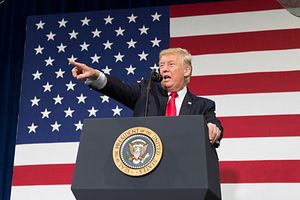In a symbolically important move, the United States decided to suspend up to as much as $2 billion in security assistance to Pakistan last week, suggesting that the future of this assistance will now be contingent on Islamabad’s response to terrorism emanating from its soil (in particular, its actions against the Afghan Taliban and the Haqqani Network). The announcement came after U.S. President Donald Trump, in his first tweet of 2018, targeted Pakistan. He tweeted: “The United States has foolishly given Pakistan more than 33 billion dollars in aid over the last 15 years, and they have given us nothing but lies & deceit, thinking of our leaders as fools. They give safe haven to the terrorists we hunt in Afghanistan, with little help. No more!”
In many ways, this is the beginning of the operationalization of the South Asia strategy that the Trump administration unveiled in August last year. Along with an expansion in U.S. military footprint, the new strategy had a strong focus on Pakistan to make sure it abides by its commitments. “Pakistan often gives safe haven to agents of chaos, violence, and terror. The threat is worse because Pakistan and India are two nuclear-armed states whose tense relations threaten to spiral into conflict,” Trump observed in his speech. “We can no longer be silent about Pakistan’s safe havens for terrorist organizations, the Taliban and other groups that pose a threat to the region and beyond,” he added. For Pakistan, the message was unambiguous, with words like “change of approach,” “a break with the status quo,” and “no partnership can survive a country’s tolerance of militants and terrorists.”
Pakistan has leveraged its centrality in U.S. Afghanistan policy for decades now, securing billions of dollars in U.S. civilian and military aid. That is now changing. Just last week, U.S. Vice President Mike Pence, while visiting Bagram Airfield, the largest U.S. military base in Afghanistan, bluntly warned Pakistan that it could no longer escape the writing on the wall that it must either act on terror havens on its land or face the wrath of the Trump administration. “For too long Pakistan has provided safe haven to the Taliban and many terrorist organizations, but those days are over as President Trump has put Pakistan on notice,” Pence underlined.
India can take comfort from this change in Washington. For far too long, New Delhi had watched helplessly as U.S. policymakers continue to mollycoddle Pakistani generals, despite growing frustration in the United States at the inability and unwillingness of Rawalpindi to desist from using terrorism as an instrument of state policy. The Obama administration did manage to reduce U.S. aid to Pakistan but it could do little to staunch the threat of terrorism in South Asia targeted at India and Afghanistan.
New Delhi, for its part, continued to work diplomatically toward marginalizing Pakistan globally and regionally. It had some successes but China’s protection has allowed Pakistan to avoid being sanctioned at the global level. And China once again decided to come to Pakistan’s rescue after Washington’s move. The Chinese foreign ministry responded by praising Pakistan’s counterterrorism actions, saying, “Pakistan has made enormous efforts and sacrifice for the fight against terrorism and has made very outstanding contribution to the global cause of counterterrorism. The international community should acknowledge that.”
While Indian diplomacy can take satisfaction from the fact that its consistent position on Pakistan is finally getting the recognition it deserves. But while there is an unprecedented convergence in the way Washington, New Delhi, and Kabul view the source of the problem in South Asia, India should also remain alert to the possibility that Washington has its own prism through which it is viewing Pakistan. And that is the United States’ continuing military footprint in Afghanistan.
Pakistan can always retaliate in several ways: by blocking the NATO supply routes to Afghanistan, by limiting counterterror intelligence cooperation, by restricting American drone strikes, and by allowing its proxies in Afghanistan to further aggravate the situation. Washington will also have to recognize that its policy in Afghanistan cannot work if it continues with its anti-Iran and anti-Russia posturing.
Yet in the short to medium term, India can certainly exploit the window of opportunity that the Trump administration’s tough posturing toward Pakistan has provided. For all the talk of China, the United States still wields enormous influence over the military-intelligence apparatus in Pakistan. This was underscored by the fact that Trump’s comments led to a meeting of the National Security Council (NSC), the country’s highest forum headed by the prime minister as well as the Corps Commanders Conference in Rawalpindi. Under global pressure, Pakistan’s financial regulatory body, the Securities and Exchange Commission of Pakistan (SECP) has banned donations to JuD, LeT, and the Falah-i-Insaniat Foundation of Hafiz Saeed. Meanwhile, the much-vaunted China-Pakistan Economic Corridor is facing some serious problems on the ground. There are voices within Pakistan asking if the present trajectory of perpetual hostility toward its immediate neighbors is yielding any dividends to Pakistan.
Given the disarray in Pakistani polity and the continuing salience of the nation’s military, it is difficult to see how a course correction can happen in Pakistan’s foreign policy or behavior. But the Trump administration has once again made it clear that it intends to keep the pressure on Pakistan intact. And that by itself is good news for New Delhi.

































